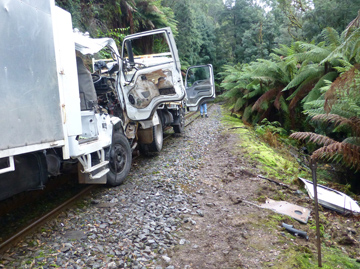
On 4 June 2013, track workers were preparing a road-rail vehicle to travel to a worksite near Rinadeena Station on the West Coast Wilderness Railway, Tasmania, when the vehicle unexpectedly started to roll backwards down a 1:20 grade. The driver was unable to slow the vehicle, so he and the passenger jumped clear, sustaining minor injuries.
The now unmanned out-of-control vehicle continued to accelerate down the steep grade, heading towards a second road-rail vehicle containing four track workers. Two passengers of the second vehicle jumped clear, sustaining minor injuries, but a third passenger and the driver were still inside when the unmanned road-rail vehicle collided with theirs.
The passenger sustained minor injuries, but the driver was trapped and seriously injured in the collision. He was subsequently removed from the vehicle and air lifted to hospital. Both road-rail vehicles were extensively damaged.
The ATSB found that the vehicle’s rear road tyres were lifted from the track to examine a suspected problem with the rear rail guidance wheels. As a result, the braking force provided by the rear road wheels was lost and the vehicle began to roll down the incline. The rail guidance wheel electric brake controller had not yet been set correctly and, as a result, little braking effort was applied through the rail guidance wheels.
... the driver was trapped and seriously injured in the collision. He was subsequently removed from the vehicle and air lifted to hospital.
The investigation also found that the West Coast Wilderness Railway had not considered all of the risks associated with the operation of road-rail vehicles on the steep railway. As a result, documented operational procedures had not been developed and locations where vehicles could be safely on and off railed had not been defined.
Other findings related to the effectiveness of the training provided to the road-rail vehicle operators, road-rail vehicle procurement standards, acceptance testing and commissioning of road-rail vehicles, reliability of the very high frequency (VHF) radio network in the Rinadeena area and radio communication protocols.
West Coast Wilderness Railway has reviewed its risk register and implemented operational procedures covering the safe operation of road-rail vehicles on the network. This has led to the development and implementation of an updated training package, procurement specifications and documented on/off tracking points. The company has also taken action to improve radio reception in the Rinadeena area and to ensure reliable communications at the station.
All organisations operating road-rail vehicles should consider the risks associated with operating the vehicles on their networks. Information on the risk of operating road-rail vehicles can be found at the Office of National Rail Safety Regulator website.
Read the report: Collision between two road-rail vehicles, near Rinadeena, Tasmania, on 4 June 2013
Additional reading - SafetyWatch: Safe work on rail


